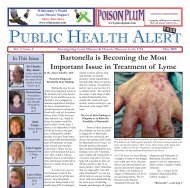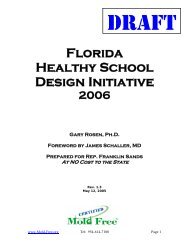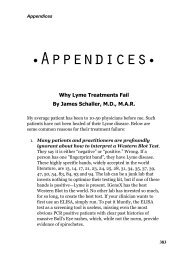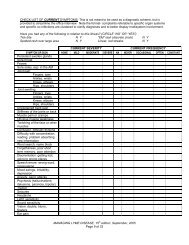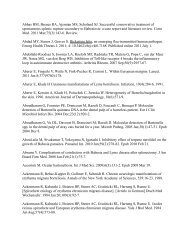Download Here - James L. Schaller, M.D., M.A.R., P.C
Download Here - James L. Schaller, M.D., M.A.R., P.C
Download Here - James L. Schaller, M.D., M.A.R., P.C
You also want an ePaper? Increase the reach of your titles
YUMPU automatically turns print PDFs into web optimized ePapers that Google loves.
Environmentally Friendly Mold Remediation Techniques That Significantly Reduce Childhood Asthma• problems with the integrity of the plastic containment around thework area. For example, doors or windows opened on a windy daycan often disturb a temporary containment made from plastic sheeting;• complacency regarding use of respirators; and• not bagging materials and not properly cleaning off surfacesbefore leaving containment area.If significant inadequacies are revealed, proper remediation protocolshould be resumed before remediation activities continue.10.2.2 Sensory ApproachThe sensory approach should be used to evaluate all moldremediation efforts, from the most routine “Minimal” problems to“Major” problems. The sensory approach involves using senses ofsight and smell to determine the presence or absence of visual andolfactory signs of conditions that support mold growth. Combinedwith evidence that effective methods for removing moldcontaminants were used and moisture problems were addressed, thesensory approach offers a practical and common sense option forevaluating whether remediation goals have been met. Sensory criteriashould include, at a minimum, that there is no visible mold growth,negligible dust, no moldy odors, and no apparent dampness.One very important indicator of mold removal effectiveness is theoverall cleanliness of the work site after job completion. The presenceof any remaining visible dust or mold indicates that cleaning andrestoration were not adequate. The presence of any dirt, moisture,debris, and dust should not be tolerated in remediated areas afterproject completion. Methods to document a sensory evaluationinclude written testimonials, photographs, white glove/black gloveinspection for dust, and confirmation by an independent third party.A white glove/black glove inspection involves allowing suspendedmatter time to settle, then wiping a finger over all or representative(previously determined) surfaces to demonstrate general cleanliness.In addition to the areas of contamination, areas that will underlierepaired or re-constructed structures should be assessed beforereconstruction.93





